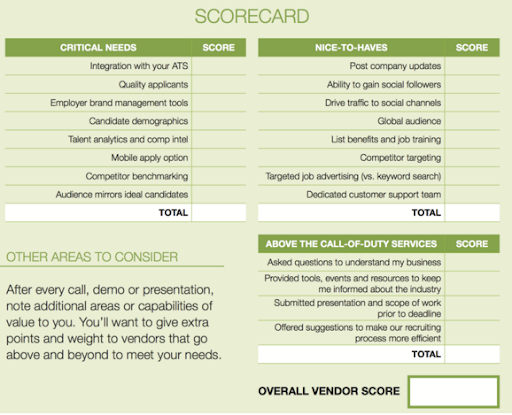Seven Steps to Selecting the Right Job Board

Out of all the channels on which employers could post open positions, online job boards still produce the most applicants—51% of today’s job seekers utilize job boards as part of their career search. Job boards are powerful for employers because they benefit recruiters trying to fill current openings and build a talent pipeline integral for keeping applicant traffic steady.
However, employers can’t expect to post on one job board and call it a day. There are hundreds of job boards out there, and choosing the right boards is crucial for scoring the best candidates. Here are seven steps to help you pick the right job board (and land your next superstar employee).
Seven Steps to Selecting the Right Job Board
- Define Your Needs
- Create Your Candidate Persona
- Understand Your Choices
- Audit Your Competitors
- Create a Strategy
- Consider Other Options
- Get an Applicant Tracking System
- Related Resources
1) Define Your Needs
Too many prospective employers arbitrarily post to job boards without any strategy. When was the last time you thought about what you need out of a job board? Before your next post, create a list of required job board functionalities. Defining your job board needs allows you to discerningly choose which board works best, rather than leaving it up to chance.

Glassdoor created this job board scorecard to help you evaluate a job board’s effectiveness.
2) Create Your Candidate Persona
You create buyer personas for customers. Why not candidate personas for job seekers? What excites candidates about a role? How do they find jobs? How are they applying? For example, more than half the traffic from Glassdoor, for example, comes from mobile devices, with individuals between 35-44 making up the majority of the mobile applications. Strong candidate personas will help you determine what job boards your ideal candidates use.
Your job candidates’ industry, education, and experience will affect which boards they use. Craigslist, for example, is great for labor-intensive positions and hospitality jobs, while business professionals gravitate towards LinkedIn.
Need help creating your candidate persona? The HiringThing Guide to Increasing Your Applicant Traffic has a candidate persona template, along with other actionable tips and tricks for writing job postings, setting up referral programs, branding yourself, and ultimately reimagining your hiring strategy to increase applicant traffic.
3) Understand Your Choices
There are hundreds of job boards. Having a working knowledge of your options will go a long way in helping you select the right board for your needs.
Paid vs. Organic Job Board Options
Some job boards are free to post at no cost. Organic postings will be organized by posting date in your chosen job board’s search results or feeds. A job post published today will appear first in a job search conducted today, while a job posted a month ago will be later in the search results or feed.
Some free boards have premium or sponsored options to ensure posts appear more frequently and earlier in search results. Most sponsored posts have a time limit (30 days, for example), and after that, the post will revert to the unpaid version. Paid or premium boards require you to pay for every posting since these boards often have advanced networks or features.
The Sponsored Advantage:
We surveyed our users, and 70% utilize organic job postings. Organic posts are a great option, but sponsored posts can take things to the next level. Indeed reports that employers are 4.5x more likely to make a hire when they sponsor a post, while ZipRecruiter finds that sponsored posts receive 11x more applicants than organic posts. It’s also a way to give yourself a competitive edge since most employers aren’t sponsoring jobs.
Major Job Sites You Should Know
There are a handful of job boards all employers should be familiar with:
- ZipRecruiter: ZipRecruiter is a job board search engine that allows employers to post jobs to hundreds of other job boards.
ZipRecruiter Daily is a new way to sponsor jobs for just $16/day. Daily instantly sponsors jobs in real-time, which you can deactivate whenever you receive your desired applicants. - Indeed: Indeed has name recognition—if you asked people on the street to name a job board, the majority would probably namecheck Indeed. Indeed is one of the most popular job boards worldwide. Since Indeed has free options and comparably low rates on sponsored posts, roles with high turnover are often posted here.
- LinkedIn: LinkedIn is the world’s most popular professional social network. LinkedIn primarily caters to business professionals and senior roles. It’s fast becoming a popular place to post due to its tremendous social reach.
- CareerBuilder: CareerBuilder is known for its close direct relationships with many Fortune 500 companies—high-level executive roles most often get posted to CareerBuilder.
- Snagajob: Snagajob is the top job board for hourly work.
- Craigslist: Craigslist started as a classified ad website that includes a job board. Craigslist is especially useful for jobs involving manual labor (contractors, landscapers), hospitality jobs (servers, hosts), or creative work (graphic designers, copywriters).
The Power of Niche Job Boards
Niche job boards are typically smaller and focused on a specific aspect of work, including location or industry. Most niche job boards are paid options since they are sponsored by and/or maintained by professional associations or support a highly specialized network.
Niche job boards are powerful because both employers and job candidates are looking for something specific. What they lack in the number of candidates giants like Indeed or ZipRecruiter provide, they make up for in highly relevant applicants.
Niche Job Boards to Know
- AllRetailJobs.com: Job board focused on, you guessed it, retail positions!
- Culinary Agents: Culinary Agents (link to CA Q&A blog) concentrates on the hospitality industry.
- Dice: Dice focuses on tech careers.
- DiversityJobs: DiversityJobs is an excellent board for those companies looking to be more inclusive in their hiring practices.
- JobsinLogistics.com: Logistics-focused.
- JobsinManufacturing.com: Manufacturing careers.
- JobsinTrucks.com: You guessed it: trucking jobs!
HiringThing partners with many paid and unpaid job boards.
4) Audit Your Competitors
What job boards are your competitors using? If your competitors are gravitating towards a job board you’ve never utilized, there may be a reason. Do some research and see why. Conversely, what boards are your competitors eschewing? Posting to these (after doing some research and ensuring they work for your hiring goals) may give you a competitive advantage.
5) Create a Strategy
You’re undoubtedly not just hiring for one type of role or one type of candidate persona, which means that you may be deploying different job boards for various purposes. Document your best practices and measure which boards are most effective, which can save time, resources, and costs for subsequent hires.
6) Consider Other Options
The 51% of job seekers who find openings on job boards still leaves 49% of job seekers finding positions elsewhere. 35% of job seekers find jobs on your website, 79% of job seekers use social media to find employment (this doesn’t mean it’s not a job board post on social media), and 70% of jobs aren’t even posted —positions get filled through networking and referrals. While job boards are a valuable tool, they aren’t an end-all solution, which you want to consider as you build your hiring strategy.
7) Get an Applicant Tracking System
An applicant tracking system (ATS) streamlines the hiring process. Employers can craft a job posting with an ATS and then post it to multiple job boards and social networks with one submission. As you can see from this post, job boards can be a beast, and a strong ATS, like HiringThing, will have direct relationships with pertinent job boards (that often result in discounts for sponsored posts or premium boards).
Check out Ten Reasons All Businesses Can Benefit from Applicant Tracking Systems.
Related Resources
- The HiringThing Guide to Increasing Your Applicant Traffic
- The HiringThing Guide to DEI Recruiting
- Innovative Strategies to Improve Recruiting and Retention
- Talent Migration: The New Recruiting Reality
About HiringThing
HiringThing is a modern recruiting and employee onboarding platform as a service that creates seamless talent experiences. Our white label solutions and open API enable technology and service providers to offer hiring and onboarding to their clients. Approachable and adaptable, the HiringThing HR platform empowers anyone, anywhere to build their dream team.


